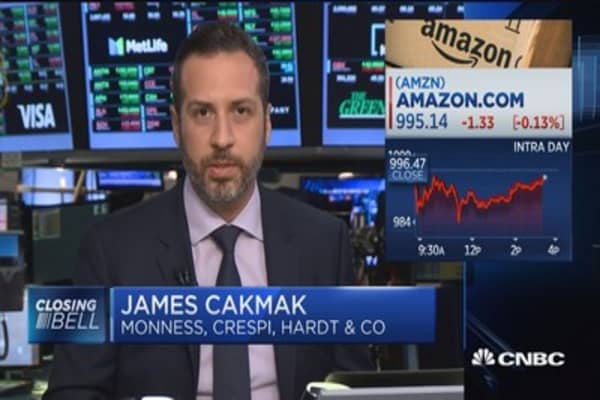Here are all Amazon’s victims. Will this trend continue?
Amazon’s victims: These stocks have lost $70 billion so far this year
- A group of 54 retailers most threatened by Amazon comprises a “Death by Amazon” index, which hit a four-year low this week and is down 20 percent on an equal-weighted basis so far this year.
- Amazon shares were lower Tuesday as it offered hundreds of deals to shoppers on “Prime Day,” a holiday it devised to promote its paid Prime membership service and other products.
- Some retail rivals’ stocks edged slightly higher, but food companies, threatened by Amazon’s purchase of Whole Foods Markets, were moving lower.
Amazon stock was lower on Prime Day and some of the retailers it has been crushing were moving higher Tuesday, but the longer-term trend shows its competitors hitting rock bottom.
Amazon’s own stock was down about 0.7 percent Tuesday, as the company offered shoppers hundreds of deals on the shopping holiday it concocted to promote its Prime membership and other products. Prime membership provides shoppers with free shipping, Amazon TV programming and other services and deals.
But Amazon, trading 2.6 percent off its all-time high, has made lofty gains compared with its brick-and-mortar rivals. For the year so far, its stock is up 32 percent, while many store chains, such as Macy’s and J.C. Penney, are down more than 40 percent.
Bespoke Investment Group created an index of the major retail names it thought would be most hurt by Amazon, called “Death by Amazon,” and it was trading at a four-year low as of Monday. The index of 54 stocks is down more than 20 percent on an equal weighted basis this year. But in market cap, the group has lost $70 billion this year alone, while Amazon has gained $120 billion, according to Bespoke.

Some of the retailers in the index edged higher, including Macy’s, which was offering free shipping to its customers Tuesday. Kohl’s, Costco, TJX, Kroger and Target were also all slightly higher Tuesday. Rite-Aidand Walgreen Boots Alliance were lower.
Most of the stocks on the list are sharply lower for the year, with a few exceptions. HSN, which is in a merger with QVC, was up 14 percent year to date. Wal-Mart, which battled back against Amazon with its purchase of Jet.com, was up about 6 percent so far this year.
“I think [Wal-Mart] got a big bounce from that move. The Jet.com acquisition was taken as a sign the company was going to get serious about online. That was one of the reasons the stock rebounded,” said Paul Hickey, co-founder of Bespoke. “It pulled in a little, and it hasn’t regained its footing since the Whole Foods news was announced.”
Amazon announced a merger last month with grocer Whole Foods Markets, rattling retail stocks, as well as some food companies. Some of those companies were selling off Tuesday, including Kellogg and General Mills.
Analysts expect Amazon, with supermarket distribution, to affect pricing for a whole raft of packaged foods. It could also be a strong booster of the Whole Foods 365 brand, creating a bigger rival for some name brands.
“I think consumer loyalty towards brands is evaporating. … This isn’t because of Amazon for these companies specifically. Consumers don’t necessarily equate quality with these old-style brands anymore,” Hickey said.
Another factor, he said, is a rally in the agricultural commodities, which means costs for cereal makers and other food companies will be higher.
As for the “Death by Amazon” index, Hickey said many more names could have been added, such as mall REITs, which have been hurt by online shopping.
But when Bespoke created the index, it chose to include only the most vulnerable retailers. The range of categories shows how broad the Amazon effect has spread. From Vitamin Shoppe to Foot Locker, Bed Bath and Beyond to Dick’s Sporting Goods, Amazon has spread pain across the retail spectrum.
Hickey said some retailers were excluded from the list because they either sold Amazon-proof products or had their own developed web strategy, like Home Depot.

Other stocks were merged away and are no longer part of the list, such as Safeway, which combined with Albertsons.
“These are the companies we think are most ‘Amazonable,'” he said. “Prime day is on 7/11, and [7-Eleven is] probably the only store that isn’t Amazonable.”
Hickey said Prime Day is a boon for Amazon, in part because of the Prime membership. “It’s the business they are building up. It’s the recurring revenues,” he said.
For other retailers, it just means future pain.
“In the U.S. retail environment, compared to other countries, there’s a ton of overcapacity in terms of square footage in stores,” Hickey said. “Until you see some of the spare capacity worked off, it’s just not a good environment for the retail sector — and the fact that Amazon is coming after them.”
Of the stocks in the index, the worst-performing year to date are Stein Mart, off 75 percent, and Rite-Aid, down 71 percent. Fred’s, Tuesday Morning and Ascena Retail are all off more than 60 percent. Hibbett Sports, Zumiez, Genesco, and Smart and Final, are all down more than 40 percent so far this year.
Stocks that are down just single digits this year are Nordstrom, PriceSmart, TJMaxx, Williams-Sonoma, Costco, Big Lots and Walgreen.

